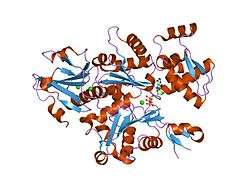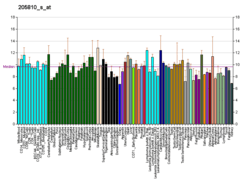WASL (gene)
Neural Wiskott-Aldrich syndrome protein is a protein that in humans is encoded by the WASL gene.[3][4][5]
The Wiskott-Aldrich syndrome (WAS) family of proteins share similar domain structure, and are involved in transduction of signals from receptors on the cell surface to the actin cytoskeleton. The presence of a number of different motifs suggests that they are regulated by a number of different stimuli, and interact with multiple proteins. Recent studies have demonstrated that these proteins, directly or indirectly, associate with the small GTPase, Cdc42, known to regulate formation of actin filaments, and the cytoskeletal organizing complex, Arp2/3. The WASL gene product is a homolog of WAS protein, however, unlike the latter, it is ubiquitously expressed and shows highest expression in neural tissues. It has been shown to bind Cdc42 directly, and induce formation of long actin microspikes.[5]
According to one study, mouse DAB1 regulates actin cytoskeleton through N-WASP.[6]
Diseases associated with WASL include Wiskottt-Aldrich Syndrome and Vaccinia.[7]
Interactions
WASL (gene) has been shown to interact with:
References
- GRCh38: Ensembl release 89: ENSG00000106299 - Ensembl, May 2017
- "Human PubMed Reference:". National Center for Biotechnology Information, U.S. National Library of Medicine.
- Miki H, Sasaki T, Takai Y, Takenawa T (Jan 1998). "Induction of filopodium formation by a WASP-related actin-depolymerizing protein N-WASP". Nature. 391 (6662): 93–6. doi:10.1038/34208. PMID 9422512.
- Fukuoka M, Miki H, Takenawa T (Sep 1997). "Identification of N-WASP homologs in human and rat brain". Gene. 196 (1–2): 43–8. doi:10.1016/S0378-1119(97)00184-4. PMID 9322739.
- "Entrez Gene: WASL Wiskott-Aldrich syndrome-like".
- Suetsugu S, Tezuka T, Morimura T, Hattori M, Mikoshiba K, Yamamoto T, Takenawa T (Nov 2004). "Regulation of actin cytoskeleton by mDab1 through N-WASP and ubiquitination of mDab1". The Biochemical Journal. 384 (Pt 1): 1–8. doi:10.1042/BJ20041103. PMC 1134082. PMID 15361067.
- "https://www.genecards.org/cgi-bin/carddisp.pl?gene=WASL". www.genecards.org. Retrieved 2018-11-25. External link in
|title=(help) - Carlier MF, Nioche P, Broutin-L'Hermite I, Boujemaa R, Le Clainche C, Egile C, Garbay C, Ducruix A, Sansonetti P, Pantaloni D (Jul 2000). "GRB2 links signaling to actin assembly by enhancing interaction of neural Wiskott-Aldrich syndrome protein (N-WASp) with actin-related protein (ARP2/3) complex". The Journal of Biological Chemistry. 275 (29): 21946–52. doi:10.1074/jbc.M000687200. PMID 10781580.
- Mizutani K, Miki H, He H, Maruta H, Takenawa T (Feb 2002). "Essential role of neural Wiskott-Aldrich syndrome protein in podosome formation and degradation of extracellular matrix in src-transformed fibroblasts". Cancer Research. 62 (3): 669–74. PMID 11830518.
- Rohatgi R, Nollau P, Ho HY, Kirschner MW, Mayer BJ (Jul 2001). "Nck and phosphatidylinositol 4,5-bisphosphate synergistically activate actin polymerization through the N-WASP-Arp2/3 pathway". The Journal of Biological Chemistry. 276 (28): 26448–52. doi:10.1074/jbc.M103856200. PMID 11340081.
- Mimuro H, Suzuki T, Suetsugu S, Miki H, Takenawa T, Sasakawa C (Sep 2000). "Profilin is required for sustaining efficient intra- and intercellular spreading of Shigella flexneri". The Journal of Biological Chemistry. 275 (37): 28893–901. doi:10.1074/jbc.M003882200. PMID 10867004.
- Suetsugu S, Miki H, Takenawa T (Nov 1998). "The essential role of profilin in the assembly of actin for microspike formation". The EMBO Journal. 17 (22): 6516–26. doi:10.1093/emboj/17.22.6516. PMC 1170999. PMID 9822597.
- Abe T, Kato M, Miki H, Takenawa T, Endo T (Jan 2003). "Small GTPase Tc10 and its homologue RhoT induce N-WASP-mediated long process formation and neurite outgrowth". Journal of Cell Science. 116 (Pt 1): 155–68. doi:10.1242/jcs.00208. PMID 12456725.
Further reading
- Ramesh N, Antón IM, Martínez-Quiles N, Geha RS (Jan 1999). "Waltzing with WASP". Trends in Cell Biology. 9 (1): 15–9. doi:10.1016/S0962-8924(98)01411-1. PMID 10087612.
- Carlier MF, Ducruix A, Pantaloni D (Sep 1999). "Signalling to actin: the Cdc42-N-WASP-Arp2/3 connection". Chemistry & Biology. 6 (9): R235–40. doi:10.1016/S1074-5521(99)80107-0. PMID 10467124.
- Suzuki T, Miki H, Takenawa T, Sasakawa C (May 1998). "Neural Wiskott-Aldrich syndrome protein is implicated in the actin-based motility of Shigella flexneri". The EMBO Journal. 17 (10): 2767–76. doi:10.1093/emboj/17.10.2767. PMC 1170617. PMID 9582270.
- Suetsugu S, Miki H, Takenawa T (Nov 1998). "The essential role of profilin in the assembly of actin for microspike formation". The EMBO Journal. 17 (22): 6516–26. doi:10.1093/emboj/17.22.6516. PMC 1170999. PMID 9822597.
- Qualmann B, Roos J, DiGregorio PJ, Kelly RB (Feb 1999). "Syndapin I, a synaptic dynamin-binding protein that associates with the neural Wiskott-Aldrich syndrome protein". Molecular Biology of the Cell. 10 (2): 501–13. doi:10.1091/mbc.10.2.501. PMC 25183. PMID 9950691.
- Suetsugu S, Miki H, Takenawa T (Jun 1999). "Identification of two human WAVE/SCAR homologues as general actin regulatory molecules which associate with the Arp2/3 complex". Biochemical and Biophysical Research Communications. 260 (1): 296–302. doi:10.1006/bbrc.1999.0894. PMID 10381382.
- Egile C, Loisel TP, Laurent V, Li R, Pantaloni D, Sansonetti PJ, Carlier MF (Sep 1999). "Activation of the CDC42 effector N-WASP by the Shigella flexneri IcsA protein promotes actin nucleation by Arp2/3 complex and bacterial actin-based motility". The Journal of Cell Biology. 146 (6): 1319–32. doi:10.1083/jcb.146.6.1319. PMC 2156126. PMID 10491394.
- Higgs HN, Blanchoin L, Pollard TD (Nov 1999). "Influence of the C terminus of Wiskott-Aldrich syndrome protein (WASp) and the Arp2/3 complex on actin polymerization". Biochemistry. 38 (46): 15212–22. doi:10.1021/bi991843. PMID 10563804.
- Qualmann B, Kelly RB (Mar 2000). "Syndapin isoforms participate in receptor-mediated endocytosis and actin organization". The Journal of Cell Biology. 148 (5): 1047–62. doi:10.1083/jcb.148.5.1047. PMC 2174535. PMID 10704453.
- Kim AS, Kakalis LT, Abdul-Manan N, Liu GA, Rosen MK (Mar 2000). "Autoinhibition and activation mechanisms of the Wiskott-Aldrich syndrome protein". Nature. 404 (6774): 151–8. doi:10.1038/35004513. PMID 10724160.
- Carlier MF, Nioche P, Broutin-L'Hermite I, Boujemaa R, Le Clainche C, Egile C, Garbay C, Ducruix A, Sansonetti P, Pantaloni D (Jul 2000). "GRB2 links signaling to actin assembly by enhancing interaction of neural Wiskott-Aldrich syndrome protein (N-WASp) with actin-related protein (ARP2/3) complex". The Journal of Biological Chemistry. 275 (29): 21946–52. doi:10.1074/jbc.M000687200. PMID 10781580.
- Mimuro H, Suzuki T, Suetsugu S, Miki H, Takenawa T, Sasakawa C (Sep 2000). "Profilin is required for sustaining efficient intra- and intercellular spreading of Shigella flexneri". The Journal of Biological Chemistry. 275 (37): 28893–901. doi:10.1074/jbc.M003882200. PMID 10867004.
- Prehoda KE, Scott JA, Mullins RD, Lim WA (Oct 2000). "Integration of multiple signals through cooperative regulation of the N-WASP-Arp2/3 complex". Science. 290 (5492): 801–6. doi:10.1126/science.290.5492.801. PMID 11052943.
- Modregger J, Ritter B, Witter B, Paulsson M, Plomann M (Dec 2000). "All three PACSIN isoforms bind to endocytic proteins and inhibit endocytosis". Journal of Cell Science. 113 (24): 4511–21. PMID 11082044.
- Marchand JB, Kaiser DA, Pollard TD, Higgs HN (Jan 2001). "Interaction of WASP/Scar proteins with actin and vertebrate Arp2/3 complex". Nature Cell Biology. 3 (1): 76–82. doi:10.1038/35050590. PMID 11146629.
- Fukuoka M, Suetsugu S, Miki H, Fukami K, Endo T, Takenawa T (Feb 2001). "A novel neural Wiskott-Aldrich syndrome protein (N-WASP) binding protein, WISH, induces Arp2/3 complex activation independent of Cdc42". The Journal of Cell Biology. 152 (3): 471–82. doi:10.1083/jcb.152.3.471. PMC 2196001. PMID 11157975.



